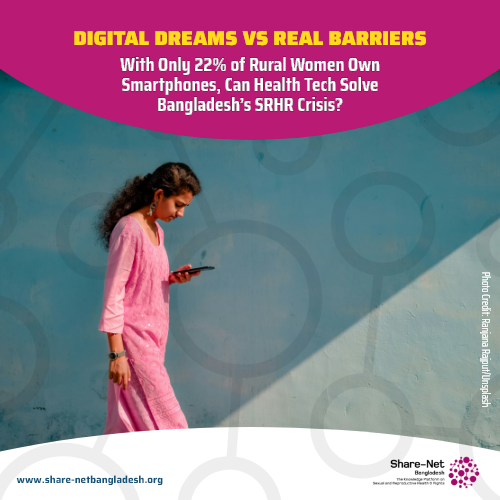Digital Dreams vs Real Barriers: With Only 22% of Rural Women Own Smartphones, Can Health Tech Solve Bangladesh’s SRHR Crisis?
In Bangladesh, where over 170 million people rely on a fragile public health system, the digital transformation of healthcare is no longer a futuristic ambition—it’s a present necessity. While the pandemic accelerated the adoption of telemedicine and digital health platforms, a deeper question remains: Can digital tools effectively improve access to sexual and reproductive health and rights (SRHR) for the country’s most vulnerable groups?
The stakes are high. As climate-induced disasters, urban-rural divides, and systemic gender inequality persist, SRHR services like maternal care, family planning, menstrual hygiene, and adolescent health often fall through the cracks. A recent study on digital healthcare transformation in Bangladesh reveals both promise and problems: numerous pilot initiatives, but no unified national framework.
Despite nearly 100% mobile network coverage, less than 30% of rural households have stable internet connectivity. For adolescent girls needing access to menstrual or reproductive health information, or women in flood-prone regions seeking maternal services, this digital divide translates to real-life consequences. Health apps and teleconsultation services simply don’t work without broadband or digital literacy.
Add to that the gendered tech gap: only 22% of rural women own smartphones, and even fewer can navigate them for health purposes. Without tailored strategies, digital health may unintentionally reinforce the very inequalities it aims to fix.
As one section of the research puts it, “No connectivity means no care.” And in a country where thousands of adolescent girls drop out of school every year due to lack of menstrual hygiene support or early pregnancy, SRHR can’t wait for perfect conditions.
So what’s the way forward?
Experts call for a national digital health law, which would define telemedicine standards, patient data protection, and equitable service delivery. They also recommend digital health hubs at union-level clinics—spaces where health workers can assist users who don’t own smartphones or can’t navigate apps.
Building trust is equally vital. A 2022 WHO report showed only 15% of rural health workers in Bangladesh are digitally trained. Without upskilling, even the best tools will sit unused. Embedding digital health modules into medical and nursing education, and creating mobile learning platforms in Bangla, are key steps.
There’s also a call for sustainable financing. Right now, over 70% of digital health projects in Bangladesh rely on donor funding. Experts suggest allocating 5% of the national health budget to digital health by 2025, rising to 10% by 2030, with a strong focus on SRHR service integration.
If done right, this digital shift could redefine healthcare for Bangladeshi women and youth. But if ignored or left fragmented, it risks creating a two-tiered system—where only the connected get care.
“Digital health must work for everyone—not just for the privileged, but also for the poor, the rural, and the unheard,” the report concludes.
This is more than a tech revolution—it’s about human rights. And in the case of SRHR, it’s about survival.
Source: TBS News


